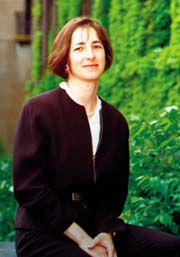Scientists light a path for new nerve cells

Molly S. Shoichet <br>Associate Professor Ph.D. (University of Massachusetts) <br>Credits: U of Toronto
System for guiding cell migration, adhesion has biomedical and regenerative medical applications
Scientists at the University of Toronto are taking regenerative medicine to a new dimension with a process for guiding nerve cells that could someday help reconnect severed nerve endings.
Molly Shoichet, a professor of chemical engineering and applied chemistry at the Institute for Biomaterials and Biomedical Engineering (IBBME), has devised a new method that helps guide cell migration and adhesion. “We’re very interested in using this system for biomedical applications and regenerative medicine, specifically for guiding nerve cells,” says Shoichet, who holds the Canada Research Chair in Tissue Engineering.
In the study, Shoichet and doctoral student Ying Luo combined a gel-like substance called agarose with compounds having “photolabile” properties that change chemically when exposed to light. When they directed laser light at the gel, its chemical composition changed, creating a “channel” through the gel. Although not a physical channel, the interaction created a “growth-friendly” chemical pathway through the agarose.
Luo then placed neural cells at the opening of the channels. She and Shoichet found that the cells migrate into and through the channels, filling the pathways rather than clinging to the periphery. “Our findings have important implications for guiding where cells go and providing a greater surface area for the neural stimuli to be transmitted,” she says. Shoichet adds that it is not yet known whether this will lead to stronger signals passing through regenerated nerves.
“This is the first example of doing 3-D patterning with this type of gel material and is applicable to transparent materials,” says Shoichet. While previous techniques have created three-dimensional gel structures, they involved a time-consuming layering process.
The study, which appears in the March 21 advanced online publication of the journal Nature Materials, was funded by the Natural Sciences and Engineering Research Council of Canada, an Ontario Graduate Scholarship and a Connaught Fellowship.
Media Contact
More Information:
http://www.news.utoronto.ca/bin5/040323a.aspAll latest news from the category: Life Sciences and Chemistry
Articles and reports from the Life Sciences and chemistry area deal with applied and basic research into modern biology, chemistry and human medicine.
Valuable information can be found on a range of life sciences fields including bacteriology, biochemistry, bionics, bioinformatics, biophysics, biotechnology, genetics, geobotany, human biology, marine biology, microbiology, molecular biology, cellular biology, zoology, bioinorganic chemistry, microchemistry and environmental chemistry.
Newest articles

Properties of new materials for microchips
… can now be measured well. Reseachers of Delft University of Technology demonstrated measuring performance properties of ultrathin silicon membranes. Making ever smaller and more powerful chips requires new ultrathin…

Floating solar’s potential
… to support sustainable development by addressing climate, water, and energy goals holistically. A new study published this week in Nature Energy raises the potential for floating solar photovoltaics (FPV)…

Skyrmions move at record speeds
… a step towards the computing of the future. An international research team led by scientists from the CNRS1 has discovered that the magnetic nanobubbles2 known as skyrmions can be…





















